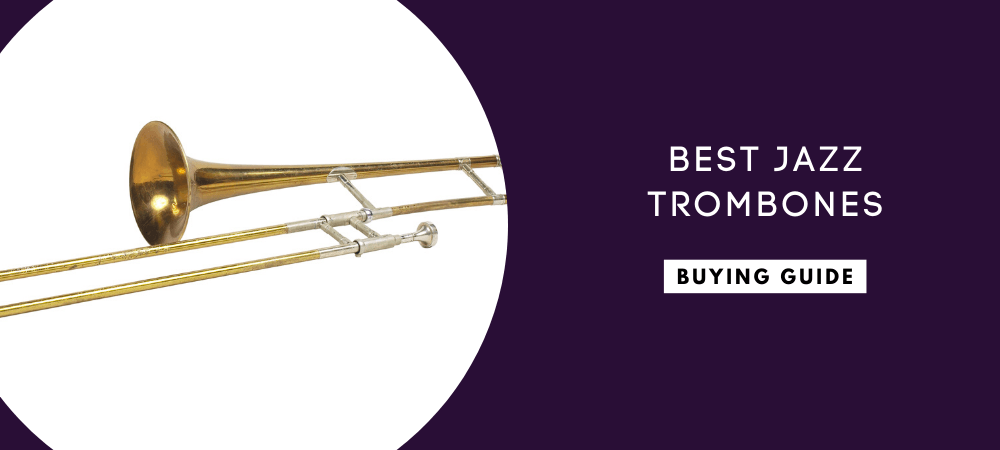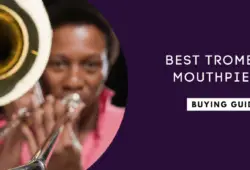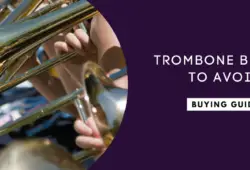There are a lot of good-enough trombones that may be okay.
But, I do not think that is what you came for here.
Let me share with you what I think are the best jazz trombones you can buy in today’s market.
Table of Contents
Best Jazz Trombones In 2024 Reviewed
Yamaha YBL-620G is among the best jazz trombones you can find.
This is definitely not the kind of instrument you get while you are experimenting with playing jazz on a trombone.
It is the kind of instrument you get if you are a professional player making a living from playing the jazz trombone.
This is not surprising anyway, considering that a bass trombone would commonly be used in a big jazz band along with other types of trombones.
The 9.5-inch gold brass (rose brass) bell creates a warm and dark tone and provides outstanding resonance.
This bell is larger than what you’d typically find on a tenor trombone, but it still manages to deliver an excellent melodious tone suitable for jazz music.
The .563” bore diameter is typical of a bass trombone, meaning playing the instrument would require a good amount of lung power.
The trombone also features a stacked double dependent rotor system in the key of Bb / F / Eb, along with an optional D slide. This additional rotor comes in handy in extending the horn’s low range even further.
Included with this instrument are a case and a mouthpiece.
- Nickel-silver bracings help guard against possible slide damage.
- Produces excellent sound with superior focus.
- Slide lock feature.
- Designed for comfortable playing.
- Has a uniquely designed, superior quality mouthpiece.
- The trombone is quite big and bulky.
This Mendini by Cecilio trombone is a budget-friendly instrument that comes with a full set of accessories.
The kit comprises a pro-deluxe durable hard case, a Cecilio 92-D chromatic tuner, a pocketbook, a pair of white gloves, a 12C mouthpiece, and a cleaning cloth.
The 8-inch bell and the .500” diameter bore are ideally suited for playing jazz.
It weighs just 11 lbs.
Better yet, the weight distribution is well balanced, so the player won’t suffer discomfort after playing for long periods.
The yellow brass bell beautifully projects a rich, bold sound, with a bright tone that’s perfectly suited for jazz music.
Actually, the yellow brass body with a beautiful gold lacquer finish is a huge bonus.
For this price point, you’d likely find trombones made from plastic, not yellow brass. Therefore, the material used not only speaks of its quality but its durability as well.
Another mark of quality is the slide action, which functions flawlessly, allowing the trombonist to execute note changes in all registers.
This might not be the most prominent jazz trombone in the market, but it is very affordable and guarantees value for money.
What’s more, the trombone comes with a 1-year warranty against any manufacturer’s defects.
- The price is excellent.
- It has a balanced weight distribution.
- Durable construction.
- Includes a ton of accessories.
- 1-year warranty.
- The case isn’t durable.
Next on our list is another budget-friendly option: the Eastar ETB-330.
It’s not often that you come across a trombone that costs less than $200, and yet looks this shiny.
The finish on this beautiful horn features a thickened lacquering process that results in excellent reflectivity and paint’s durability.
The whole look is very clean. With proper maintenance, you never have to worry about the paintwork on this instrument scraping off, even in the ‘heavy-duty’ sections.
In addition to looking attractive, the horn plays beautifully as well.
The high-quality timber produced is bright and penetrating. The sound is even, and the instrument offers a quick response, coupled with accurate tones.
Well, judging from the yellow brass body, you wouldn’t expect anything less, now would you?
This light trombone weighs just 9.6 lbs, and the weight is evenly distributed to lessen fatigue while playing.
The bore is .528” in diameter while the bell is 8.11”. Both these features make it a suitable trombone for playing jazz.
Brass chrome plating has been used on the slide, thereby resulting in higher hardness, higher brightness, durability, and faster action when playing.
You never have to worry about this slide deforming, oxidizing, or sticking.
The trombone comes with a pair of white gloves, oil, wipes, telescopic oil, a cleaning rod, a short brush (for the mouthpiece), a long-hair brush (for bend one), a shoulder pad, a 7C mouthpiece, and a hard case.
- Very well priced.
- Wear-resistant and durable.
- Very lightweight yet robust.
- The cleaning kit has been included.
- It comes with a shoulder pad.
- The slide requires ample lubrication at first.
EastRock guarantees that their trombones go through two professional checks before they leave the factory en route to their buyer.
With such an assurance, you know that a lot of time and effort has been spent in ensuring that all EastRock trombones
The yellow brass body is responsible for the bright tone produced, while the long bore allows for better sound transmission.
The bore size is .500” in diameter while the bell size is 9.252”.
The bell is larger than what you’d find on a typical jazz trombone, but this is a straight tenor trombone, so it can be used for jazz.
The overall structure of this instrument looks very beautiful and clear.
The professional paint used ensures durability so that with regular use, expect the surface to remain that bright and fresh for about 2-4 years.
To ensure this remains so, the trombone comes with an attractive ABS hard case that will adequately protect the instrument from any drops and dings.
Weighing 13.5 lbs., the weight is well distributed to prevent the player from experiencing any fatigue while playing the instrument.
- The large bell produces a powerful sound.
- Durable and wear-resistant.
- Long-lasting fade-resistant paintwork.
- It comes with a hard case.
- 2-year warranty.
- It has a very wide bore.
For decades, King 3B has been very popular with jazz players, and the price tag shows that it’s intended for professional trombonists.
This is a great lead instrument that can deliver clear and present solos. It is also a beautiful studio instrument that’s great for recording.
This medium-bore trombone measures .508” in bore diameter and a bell size of 8”.
The one-piece hand-hammered yellow brass bell allows for continuous even vibrations; while at the same time, delivering a bright and vibrant sound ideal for jazz music.
You get outstanding projection and response, along with a brilliant, arresting tone, notably in the upper register. What more could you possibly ask for in a jazz trombone?
A clear lacquer finish helps prevent minor scratches on the instrument and keeps the paintwork protected from everyday wear and tear.
Outer slides on this trombone are constructed from Nickle silver, which allows for a vibrant, excellent tone and quick response resulting from their fluid action.
Better yet, this instrument comes with an optional F-attachment for players who may prefer using one or those who may need the broader range on occasion.
If you are looking for a jazz horn that you can live with for a long time, then the King 3B will suit you perfectly.
The trombone comes with a 12C mouthpiece and a wood shell case.
- An all-round versatile horn.
- Suitable for both lead and solo playing.
- Perfect for studio recording.
- Swift response.
- Has a reverse tuning slide.
- It’s costly.
The first thing you might notice about this instrument is the tiny bore. Measuring .488” in diameter, the bore tubing has been made that small to enhance the playability of the trombone.
Despite the small bore, the trombone has a standard shank that can be fitted with a 12C mouthpiece.
The 8” bell projects sound wonderfully, while its yellow brass construction delivers the bright tone that’s needed for jazz.
Another feature you’ll find on this instrument and not on typical trombones are the valves.
The 3, upright trumpet-style valves house Monel pistons that operate smoothly and provide a fast response.
Also, unlike on typical trombones, this whole instrument (both the valves and the slide), plays in the key of Bb.
Weighing 16 lbs, this instrument is quite lightweight, allowing the trombonist to play for extended periods without experiencing fatigue.
The package includes a Cecilio 92-D chromatic tuner, a pair of white gloves, a cleaning cloth, and a pro-deluxe durable hard case.
- The unique small bore enhances playability.
- Uses superior-quality Monel pistons.
- A balanced design that’s comfortable to hold.
- Smooth and fast valve action.
- 1-year warranty.
- It takes some getting used to.
If you are particularly concerned about the weight of a trombone while playing jazz, consider getting the Selmer Prelude TB711.
This lightweight instrument weighs a mere 4 lbs.
This well-constructed trombone has a very clean basic look and design that makes it comfortable to play and carry around as well.
It has an 8” bell and a .509” bore, which is just what you’d want in a straight tenor trombone for playing jazz music.
The small bore is designed for ease of tone production, and it also allows for proper embouchure development as the trombonist masters the instrument.
Furthermore, this instrument comes with a genuine Vincent Bach 12C mouthpiece. Quite impressive, wouldn’t you agree?
The two-piece bell allows for even vibrations, and its yellow brass construction produces a bright and vibrant tone that’s well projected.
Chrome-plated brass inner slides are durable and provide smooth action for effortless transition between notes.
The instrument comes with Bach slide cream that’s enough to run you several months. Additionally, a hard-shell case is also included to protect your trombone and allow for easy transportation.
- It is reasonably priced.
- Very lightweight.
- Has a removable balance weight.
- Robust construction using top-notch materials.
- Easy to play.
- It is unusually long.
What Makes A Trombone Fit to Play Jazz?
In a jazz orchestra (aka a big band), you’d typically find 5 saxophones, 4 trombones, 4 trumpets, and a rhyme section consisting of guitar, bass, piano, and drums. In some instances, there may additionally be a vibraphone, clarinet, violin, and singers.
In jazz bands, the trombone plays in the tenor range, below the trumpet, whereas in large bands, the entire trombone section often plays together as a unit.
When it comes to the former (small band) setup, the trombone serves as a lower, alternate voice to the other instruments.
It’s quite the elaborate setup, and the instruments come together beautifully to give you the iconic sound of jazz music.
Meaning, all these instruments have been meticulously selected to fit the bill.
So, what is it about the trombone that made it suitable for jazz?
a) The Glissando Effect
One reason why the trombone is such an invaluable instrument in jazz is because of the slide.
The trombone is one of the few wind instruments that can produce a true glissando, synonymous with jazz music.
b) The Ability to Play in Tune
A skilled and experienced trombonist will be able to play in virtually perfect tune at all times, even when the instrument isn’t in tune.
See, when it comes to the trombone, there are various ways the player could compensate for an out-of-tune instrument. They could adjust the slide positioning or change the embouchure, therefore allowing them to play in perfect tune, even when using an improperly tuned trombone.
This gives the trombone a considerable advantage over many other instruments, such as the piano.
c) Ease and Fluidity of Bending Notes
Can this brass instrument be a bit clunky? Yes, of course.
However, in the right hands, the trombone can be a pretty intuitive instrument that’s easy to handle.
With a trombone, the player can effortlessly slide into notes and choose from multiple positions so that they can efficiently execute a melody.
Additionally, the slide can also offer an enhanced, more easily controlled vibrato.
d) It Has A Wide Range
The trombone can play a wide range of notes.
The tenor trombone, which is commonly used in jazz, has a range stretching from the E note below the bass clef to the B flat above middle C.
Experienced trombonists can push this range even further by producing a note as high as F5, above the B flat.
Additionally, some trombones could come with a trigger (F attachment), that activates additional tubing built into the instrument. This extra tubing allows the player to reach a low C note, below the bass clef.
e) Versatility
This instrument can play many styles of music, both in an ensemble and solo. Not to mention that it has a broad range of pitches, therefore allowing it to play any musical genre, including jazz!
At the same time, the upper range of a trombone can almost match that of a trumpet, which allows a composer to use the instrument is very many ways.
The slide mechanism also contributes to the versatility of the instrument. A player has different creative avenues than those offered by valves, which makes the instrument very expressive.
With a trombone, you can play big brassy bass hits just as easily as you can hit sparkling high melodic lines.
f) Unique Tone
The low pedal tones of a slide trombone are bright and project splendidly. This makes them preferable over the darker-sounding valve trombones.
Also, the cutting tone of this brass instrument can be adjusted depending on the mouthpiece, shaft size, and playing technique.
The low tenors of a jazz trombone complement the bass, bringing it out beautifully. Likewise, the bassist also brings out the trombone, so they are a perfect match in any band.
g) Improvisation
One unique aspect of jazz compositions is that musicians can make up their own music on the spot. This is known as taking a ‘solo’.
While trumpets and saxophones improvise between the lyrics (if the band has a vocalist), trombones only improvise when it’s their turn to solo.
This is a huge role played by trombonists in a jazz band.
Things to Consider When Buying A Jazz Trombone
Type of Trombone
A tenor trombone is the most widely played trombone, and it is also the typical instrument many people refer to when talking about a jazz trombone.
The midrange tone of a tenor trombone helps it stand out in a jazz band, making it a perfect fit for jazz.
However, it is worth noting that the tenor isn’t the only trombone used in jazz. Bigger jazz bands may include a bass trombone, in addition to the tenor.
When used in jazz bands, the bass trombone pairs well with the tuba, helping to enhance the band’s low end.
Bell Material
Trombone bells may be made on yellow brass, red brass, gold brass, or sterling silver. Yellow brass is the most common material used, and it tends to produce brighter tones. Red brass has a higher copper content, and this leads to a darker tone.
Since jazz trombones need to have a bright tone, you should go for a yellow brass bell.
Bell Size
Bass trombones will have larger bells than tenor trombones. As a result, bass trombones are used in orchestras, whereas tenor trombones are used in jazz.
A tenor trombone bell size ranges between 7in and 9in (18-23 cm) in diameter, but 7.5in to 8.5in (19-22 cm) is often the typical bell size.
Bell Construction
A trombone bell may be constructed from two separate brass sheets or out of a single sheet of metal, hammered on a mandrel until the correct shape is achieved.
A one-piece, hand-hammered bell is considered a higher quality feature that gives off a similarly high-quality sound.
Bore Size
A trombone’s bore is the inner diameter of the inner slide. This measurement is expressed in thousandths of an inch.
Bore sizes may range from .500” (for student trombones) to .547” (for symphonic use), to up to .562” (for bass trombones).
When it comes to a jazz trombone, you want to go for a small bore.
Smaller bores produce a brighter, more focused sound while larger bores give off a warmer (darker), bigger tone.
Besides having an impact on the tonal quality, the bore size also affects a horn’s resistance or back-pressure.
With a smaller bore, more resistance is created, making it easier to produce the right tone and allowing for more versatile use of the instrument.
Straight Horn Vs. Trigger Trombone
On the one hand, you have the standard trombone, also known as the straight trombone.
On the other hand, you have the trigger trombone that comes with additional tubing inside the instrument; and an F-attachment.
The complex construction of a trigger trombone extends a trombone’s capabilities by adding notes to the horn’s low range. This design also makes it easier to play certain notes.
Jazz trombonists tend to stick with straight tenor trombones, leaving the trigger trombones for orchestra players.
Valve Trombone Vs. Slide Trombone
Typically, regular trombones have a slide function. However, we do have valve trombones which do not have a slide. Instead, they function much like a trumpet.
The fundamental design of both trombones is the same.
The difference only comes in when considering the mechanism that’s used to lengthen or shorten the length of the tube to produce the various notes.
Not changes sound easier on a slide trombone, but a bit harder on a valve trombone. The difference is subtle, but a seasoned trombone player can hear it.
Additionally, while a slide trombone is more ‘free-blowing’; a valve trombone tends to sound a little ‘stiffer’.
Since the slide trombone is the standard, it’s what you’d typically find being used to play jazz.
Even so, jazz musicians who like to hit notes quickly will readily adopt the valve option.
A valve trombone may not allow you to execute a true glissando for jazz effect, but it adds a distinct sound to arrangements.
Mobility
When it comes to the mobility of the instrument, it is easy to tell a jazz trombone apart from a symphony trombone (used in orchestras).
While playing jazz, it is crucial to be able to move around on the instrument easily and freely. (forum)
For this reason, jazz trombones often feature a smaller bell, thinner walls, and a smaller bore size. You’ll also notice that the gap between the slide is narrower.
Ultimately, all these features are designed to make the instrument smaller, thereby increasing slide mobility.
FAQs About The Best Jazz Trombones
Is Getzen a Good Trombone Brand?
Yes, it is.
All around the world, Getzen trombones are famed for their playability and durability.
These horns feature hand-spun bells, and the fastest, smoothest possible slide action.
Better yet, Getzen offers custom series jazz trombones that allow the player to customize the horn to get their desired resistance, sound, and response.
How to Play Jazz Using A Trombone?
Playing a jazz trombone isn’t too different from playing a regular trombone.
Nevertheless, here are a couple of things to keep in mind while playing jazz using a trombone:
- Swinging eighth notes is the basis of jazz music. So, unless otherwise stated, always assume that the eighth notes are swung while playing jazz music.
- You’ll need to buzz the right pitch with your lips.
- Master the art of bending notes. When you hold out a note for a while, try giving it a slight vibrato. If you aren’t the lead, follow the lead trombone to get an idea of when to vibrato and for how long.
- Work relentlessly on your articulation. While practicing, make sure you are using a metronome as this will ensure you are playing in time and swinging.
- The blues scale is fundaments to jazz music, so make sure you master it as this will help with improvisation. Know your chords (arpeggios) as well.
- Work with alternate positions, as this also helps you take advantage of many natural slurs.
Here’s a video to help guide you in playing a jazz trombone:
Is It Hard to Learn the Trombone?
Yes, it is. More so if you have never played a brass instrument before.
One reason why the trombone is not just a hard instrument to learn but a hard one to play as well is because this isn’t a fixed-pitch instrument.
The player would need to continually make tuning adjustments on the fly, posing not just a musical challenge but a physiological one as well.
At the same time, playing the instrument requires a great deal of air, which makes it a very athletic endeavor.
Playing a note correctly on the trombone requires a couple of things:
- Great embouchure
- Buzzing the right pitch with your lips
- Putting the slide in precisely the correct position for that pitch
- Controlling the speed and temperature of your air
- Making fine adjustments with the slide hand for tuning purposes,
- Articulating with the tongue, etc.
Furthermore, all these have to be done simultaneously. So, as you can see, playing the trombone is no easy feat.
All the same, learning this unique horn instrument would be a nice challenge for a player.
Mastering how to play it correctly can be very rewarding as well, as you’ll get to see just how fun playing the trombone is.
Conclusion
Playing the trombone takes a lot of muscle and pitch memory, and finding a suitable jazz trombone might be just as challenging.
What you need to remember is that jazz is about freedom and expressiveness. So do not shy away from trying different horns, techniques, and playing styles.
Know jazz songs in different keys, study the players you look up to, hand out listening to good players, and play with other trombonists as much as possible.
All this will help you find an individual playing style that’s unique to you, and isn’t that just the whole point of playing a jazz trombone?













